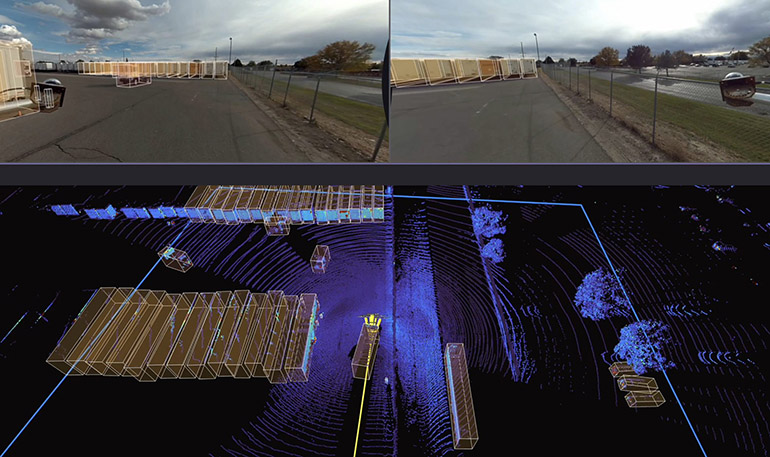|
Listen to this article  |
Outrider Technologies Inc., an early entrant in autonomous yard operations for logistics hubs, this week released the latest update to its AI-driven perception technology. Trained by millions of data points collected from Fortune 500 customer distribution yards, Outrider has designed its system to understand, anticipate, and interact with diverse fixed and moving actors in the yard.
The Golden, Colo.-based company said its updated perception system will enable it to achieve critical safety and performance objectives for commercial driverless operations in 2024. With its integrated technology, Outrider claimed that it is evolving quickly to handle the complexities of logistics hubs.
The company added that its product can perform fully autonomous, zero-emission trailer moves. The new release bookends a breakout year for Outrider. Highlights of 2023 include a $73 million Series C financing round – bringing its total funding to $191 million — as well as the expansion of its engineering workforce by 20% in Europe and Latin America.
Andrew Smith, co-founder and CEO of Outrider, recently sat down with The Robot Report to provide an update on the company.
Updated stack includes deep learning, safety features
What are the key features of this new release from Outrider?
Smith: With the perception stack that we released, three things are new. First of all, during 2023, we accelerated the data collection in the field to update tens of millions of additional datasets across customer networks for the best possible training of our deep learning models on that perception stack.
That increased data collection and new deep learning models using best practices in the industry [are] being layered on top of fourth-generation sets of multimodal sensors and compute on those trucks. They’re essentially the commercial package that we’ll be rolling out next year for driverless yard operations.
Second, this perception stack also enables the safety case that we expect to be the standard of the industry, where you have models trained from a high diversity of sites to maximize safety for everyone using the technology and for the remaining over-the-road drivers and other personnel in these yards.
 Submit your nominations for innovation awards in the 2024 RBR50 awards.
Submit your nominations for innovation awards in the 2024 RBR50 awards.
Third, the latest capability of the perception system not only identifies obstacles but also identifies the direction and velocity of those obstacles. This is useful for two things. First, we can can identify if something is starting to approach where we are or what we would consider the safety bubble around our vehicle. So we can reduce our speeds in advance of ever getting close to someone while still maintaining non-AI-based redundant safety mechanisms.
Second, the perception capability now sees farther out and has better predictive capabilities of the direction and movement of that system. So our safety systems can work better, as well as being able to be more efficient in the work we do in the yard. Essentially, you’re navigating like a human would by understanding the intention of different obstacles and actors in the yard.
What’s the latest with the autonomous trailer-connection system?
Smith: The enhanced sensor suite allows for expanded weather operations or all-weather operations. This perception system is the last piece of the puzzle.
The deep learning models that we’ve developed for identifying and automating the disconnection and connection of trailer airlines will now be 40% faster with the new perception system release.

Outrider’s perception update is designed to anticipate behavior in distribution yards. Source: Outrider
Outrider considers new opportunities
Are you expanding internationally yet?
Smith: The initial deployment is happening in North America, but we have customer and prospect relationships across the globe.
The pain point of yard operations is universal. It’s not only about the cost of drivers. It’s about recruiting and retaining people. It’s about safety.
When you have the right trailer at the right place at the right time, you can improve efficiency inside of production or warehouse facilities. We know when one of our customers’ trucks is about to arrive, and we can pick up a trailer right at the gate and have the trailer they’re picking up pre-staged, so long-haul divers can dramatically reduce their turnaround time.
Several ports have automated all of the container loading and unloading from the ships, but what about automating the ground movement of shipping containers around the port? is that another opportunity for Outrider?
Smith: Outrider will serve port operations as well. We’re currently focused on distribution yards just because it’s this massive green space that has been looking for a solution for a long time.
When it comes to ports, we will be expanding the availability of our system to port operations, especially since the safety and perception capabilities of our system are dramatically ahead of the initial autonomous port operations. So we can bring in the technology where it’s not an isolated area and a port operation.
What are some other noteworthy developments for your company?
Smith: Earlier this year, we also announced our AI-driven trailer inventory capability. With the Outrider yard trucks, we can also catalog and inventory all of the trailers in the yard, and then update the trailer inventory management system.
The Outrider yard truck can use its vision cameras to read the serial numbers or license plates of the vehicles to identify and track where each trailer is located. This helps save time finding “lost trailers” in a large yard.
Credit: Source link


Comments are closed.